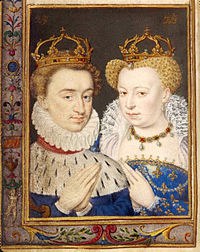The Unique Career of Marguerite de Valois, Queen of Navarre
by Dominic Pearce
Chapter 1: The Valois Princess
Marguerite de Valois was born on 13 May 1553 at the Chàteau of St Germain-en-Laye, a few miles to the west of Paris.[1] The little girl was the seventh child (third daughter) of Henri II and his wife Catherine de Médicis. Henri II died in 1559, when his daughter was six. This tragedy was the result of the famous jousting accident which deprived France of a strong king at a bad time, as I described when I last wrote for Tudor Times. In her memoirs – Marguerite was a writer – there is no impression that she knew her father well. She laments him conventionally as a terrible loss to France. But her mother would be a huge influence.
By the time the princess became marriageable France was well advanced in civil war, made possible by the weakness of the Crown. Henri II was succeeded by his eldest son François II, who died in December 1560 (aged sixteen), leaving the throne to his ten-year-old old brother Charles as Charles IX. Young kings were not a good bet in the sixteenth century.
Fighting started in 1562. The power struggle that emerged by 1570 (Marguerite was seventeen) was three-cornered. The Guise family championed total Catholicism supported by the Pope and the King of Spain; the Bourbon family led the Huguenots (French Calvinists); while the Crown, championed by the queen mother, Catherine de Médicis, tried for compromise and fought for French independence of foreign powers.
Marguerite was a pawn in this game of the highest possible stakes. Not that she was passive. The first indication of her cast of mind was an attempt to marry Henri, Duke of Guise. The Spanish ambassador told Philip II of Spain that Marguerite’s mother and brother, King Charles IX, attacked her physcially to make her give up Guise. She was so badly beaten that her clothes were torn and ruined.[2] Such was Valois family life. Instead she married her cousin Henri, Prince of Navarre.
Marguerite was a devout Catholic, while Henri was a Huguenot, raised as such on the insistence of his own mother, Jeanne d’Albret, Queen of Navarre.[3] In short it was the first match since the Reformation between a Catholic princess and a Protestant prince. Reconciliation was needed. Tens of thousands of French had died so far in the fighting which was punctuated by peace treaties which never held. There had already been the Edict of Amboise (1563) and the Peace of Longjumeau (1568), and now there was the Peace of St Germain-en-Laye.
Catherine de Médicis was the real sovereign of France at this time, acting first as regent for her under-age son Charles IX, then as the power behind the throne after he reached his majority (in 1563).[4] Because of later events Catherine has suffered from a poor reputation in the historical tradition, but the truth is that she always tried for a settlement. It was not her fault that war returned every time. The entrenched hostility of the ultra-Catholic Guise to peace lay partly – largely? – in their wish to dispossess the Huguenot lords and occupy their lands.
The Bourbon-Valois marriage was dynastic. Henri de Navarre was the ‘First Prince of the Blood.’ This meant that he was head of the family that stood in succession to the reigning Valois, should the Valois run out of male heirs (something that seemed out of the question).[5] A match between Marguerite and Henri de Navarre was, in other words, a support to the ruling family ‘re-uniting’ the ancient Capetian dynasty. It was a power marriage which also, because of the two religions involved, symbolised compromise.

Despite the glamour of the nineteen-year old bride and the rampant heterosexuality of the eighteen-year old groom there was no chemistry. Marguerite, tall white-skinned and generally blonde (her hair was naturally dark – but she wore wigs and also coloured her hair), was already famous for her beauty and style. The Abbé de Brantôme said (repeatedly) that she was the most beautiful woman in the world.[6] He was one of many admirers. Her husband was not.
Nor did Navarre appeal to Marguerite. Henri de Navarre was agile but short. He was unkempt by Valois standards. Formidable qualities would emerge with time but even later on Henri did not embrace cultural refinement. He was never an art-lover. He did not write poetry. He was earthy but she was a sophisticate. Marguerite pulled off the difficult trick of being both a fashion icon and an intellectual, who later astonished the court by her mastery of Latin, when she replied without hesitation to a long speech in that language by a Polish ambassador.[7]
The details were negotiated between Catherine de Medicis and Jeanne d’Albret. Jeanne very much wanted her son to marry Marguerite but took a different view of the glittering princess from the adoring Brantôme.
‘As for her beauty, I agree she has a good figure but she holds herself in too much. As for her face, she uses so much help, it does irritate me, because she will ruin herself. But in this court make-up is normal just like in Spain.’[8]
Jeanne missed the wedding, dying (probably of cancer) on 9 June 1572.
[1] I have accepted the dating of Janine Garrisson in her biography Marguerite de Valois (Fayard 1994) p 13
[2] Garrisson p 40
[3] Jeanne was queen regnant of Navarre, queen in her own right. Basse-Navarre consisted of a few mountain valleys (the larger part of Navarre being south of the Pyreneses, and in the possession of the King of Spain), but Jeanne possessed much larger territories in the south-west of France. Her husband Antoine de Bourbon, Henri’s father, who died in 1562, also had large possessions, mainly Vendôme and the Bourbonnais in the centre of France.
[4] French kings reached their majority at the beginning of their fourteenth year.
[5] Both the Bourbons and the Valois descended in the male line, father to son, from St Louis (Louis IX) who ruled France in the thirteenth century. In the female line they were more closely connected – Henri’s grandmother and Marguerite’s grandfather were sister and brother – but
it was the male line descent that counted for the royal succession in France.
[6] Mémoires de Pierre de Bourdeille, Seigneur de Brantôme, contenans Les Vies des Dames Illustres de France (1665) p 202 to start with.
[7] Brantôme p 223
[8] Garrisson p 50










